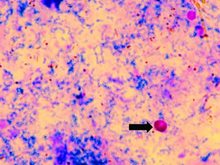Cryptosporidium muris
| Cryptosporidium muris | |
|---|---|

| |
| Cryptosporidium muris oocysts | |
| Scientific classification | |
| Domain: | Eukaryota |
| Clade: | Diaphoretickes |
| Clade: | SAR |
| Clade: | Alveolata |
| Phylum: | Apicomplexa |
| Class: | Conoidasida |
| Order: | Eucoccidiorida |
| Family: | Cryptosporidiidae |
| Genus: | Cryptosporidium |
| Species: | C. muris
|
| Binomial name | |
| Cryptosporidium muris Tyzzer, 1910
| |
Cryptosporidium muris is a species of coccidium, first isolated from the gastric glands of the common mouse.[1] Cryptosporidium does originate in common mice, specifically laboratory mice. However, it also has infected cows, dogs, cats, rats, rabbits, lambs, and humans and other primates.
Characteristics
Cryptosporidium muris infects dogs, rabbits, lambs, cats, humans, and non-human primates.[2] This type of cryptosporidium infects people and animals by the oocyst acquired in water. If people or animals drink the water, then they could become infected and then complete the cycle by passing oocysts. People and animals can also become infected by being in water that has the oocysts present. The area where Cryptosporidium muris most commonly occurs is in Kenya, France, Thailand, and Indonesia. It also occurs in the western hemisphere but to a far lower amount.[citation needed]
Infection
The current diagnostics for Cryptosporidium muris are Polymerase Chain Reaction (PCR), Restriction Fragment Length Polymorphism (RFLP), and DNA sequencing. Diagnostic tests can be frustrating as it is highly difficult to differentiate between species and the treatment would be the same for all species. Cryptosporidium muris is resistant to disinfectants; it has been discovered that ultraviolet or UV light helps to kill the species.[3] As for prevention, people should not drink infected water or play in it. Also making sure to practice good hygiene improves the risks of not contracting Cryptosporidium.[4]
Prevalence
Cryptosporidium muris has prevalence in the following species in the following amount: Dairy Cows -68% Feedlot Cows- 80% Mice- 26%, and Rats- 5%.[5]
References
- ↑ Tyzzer EE (1910). "An extracellular Coccidium, Cryptosporidium Muris (Gen. Et Sp. Nov.), of the gastric Glands of the Common Mouse". J Med Res. 23 (3): 487–510.3. PMC 2098948. PMID 19971982.
- ↑ Gatei, Wangeci; Ashford, R. W.; Beeching, N. J.; Kamwati, S. K.; Greensill, J.; Hart, C. A. (2002). "Cryptosporidium muris Infection in an HIV-Infected Adult, Kenya". Emerging Infectious Diseases. 8 (2): 204–206. doi:10.3201/eid0802.010256. PMC 2732451. PMID 11897075.
- ↑ Palmer, Carol J.; Xiao, Lihua; Terashima, Angélica; Guerra, Humberto; Gotuzzo, Eduardo; Saldías, Gustavo; Bonilla, J. Alfredo; Zhou, Ling; Lindquist, Alan; Upton, Steve J. (2003). "Cryptosporidium muris, a Rodent Pathogen, Recover from Human in Peru". Emerging Infectious Diseases. Center for Disease Control and Prevention. 9 (9): 1174–1176. doi:10.3201/eid0909.030047. PMC 3016761. PMID 14519260. Archived from the original on 2018-06-23. Retrieved 2023-02-22.
- ↑ Chappell CL, Okhuysen PC, Langer-Curry RC, Lupo PJ, Widmer G, Tzipori S (2015). "Cryptosporidium muris: Infectivity and Illness in Healthy Adult Volunteers". Am. J. Trop. Med. Hyg. 92 (1): 50–5. doi:10.4269/ajtmh.14-0525. PMC 4347390. PMID 25311695.
- ↑ Anderson, B. C (1991). "Prevalence of Cryptosporidium muri-like oocysts among cattle populations of the United States: Preliminary report". The Journal of Protozoology. 38 (6): 14S–15S. PMID 1818141.
Further reading
- Palmer, Carol J., et al. "Cryptosporidium muris, a rodent pathogen, recovered from a human in Peru." Emerging infectious diseases 9.9 (2003): 1174.
- Katsumata T, Hosea D, Ranuh IG, Uga S, Yanagi T, Kohno S (2000). "Short report: possible Cryptosporidium muris infection in humans" (PDF). Am J Trop Med Hyg. 62 (1): 70–2. doi:10.4269/ajtmh.2000.62.70. hdl:10069/20123. PMID 10761726. S2CID 15475462.
{{cite journal}}: CS1 maint: url-status (link) - Gatei, Wangeci, et al. "Cryptosporidium muris infection in an HIV-infected adult, Kenya." Emerging infectious diseases 8.2 (2002): 204–206.
- Koudela B, Modrý D, Vítovec J (1998). "Infectivity of Cryptosporidium muris isolated from cattle". Vet Parasitol. 76 (3): 181–8. doi:10.1016/s0304-4017(97)00217-3. PMID 9615952.
- McDonald V, Deer R, Uni S, Iseki M, Bancroft GJ (1992). "Immune responses to Cryptosporidium muris and Cryptosporidium parvum in adult immunocompetent or immunocompromised (nude and SCID) mice". Infect Immun. 60 (8): 3325–31. doi:10.1128/IAI.60.8.3325-3331.1992. PMC 257318. PMID 1639500.
- Lupo PJ, Langer-Curry RC, Robinson M, Okhuysen PC, Chappell CL (2008). "Cryptosporidium muris in a Texas canine population". Am J Trop Med Hyg. 78 (6): 917–21. doi:10.4269/ajtmh.2008.78.917. PMID 18541769.
External links
- "Cryptosporidium muris" at the Encyclopedia of LifeLua error in Module:EditAtWikidata at line 36: attempt to index field 'wikibase' (a nil value).Lua error in Module:WikidataCheck at line 23: attempt to index field 'wikibase' (a nil value).